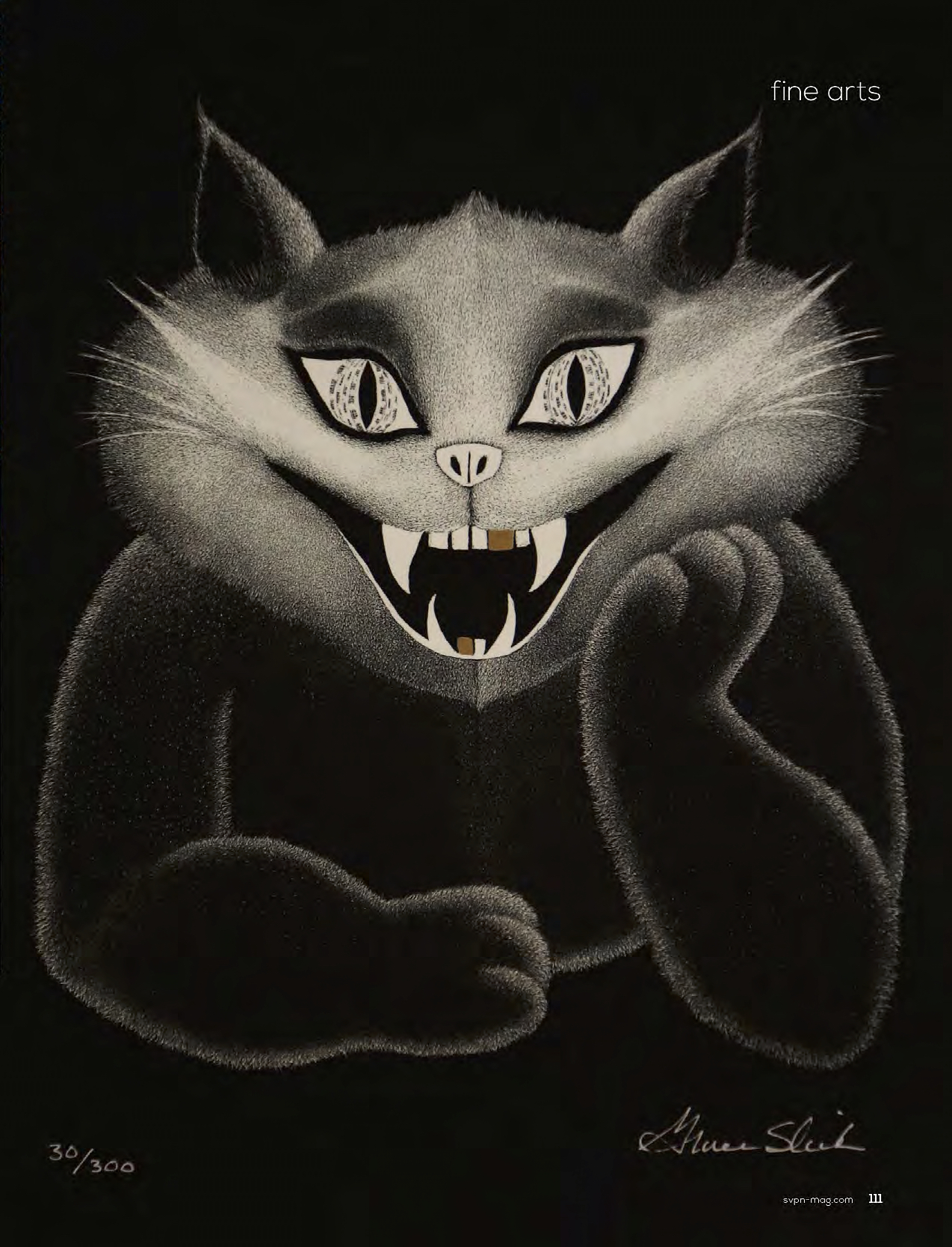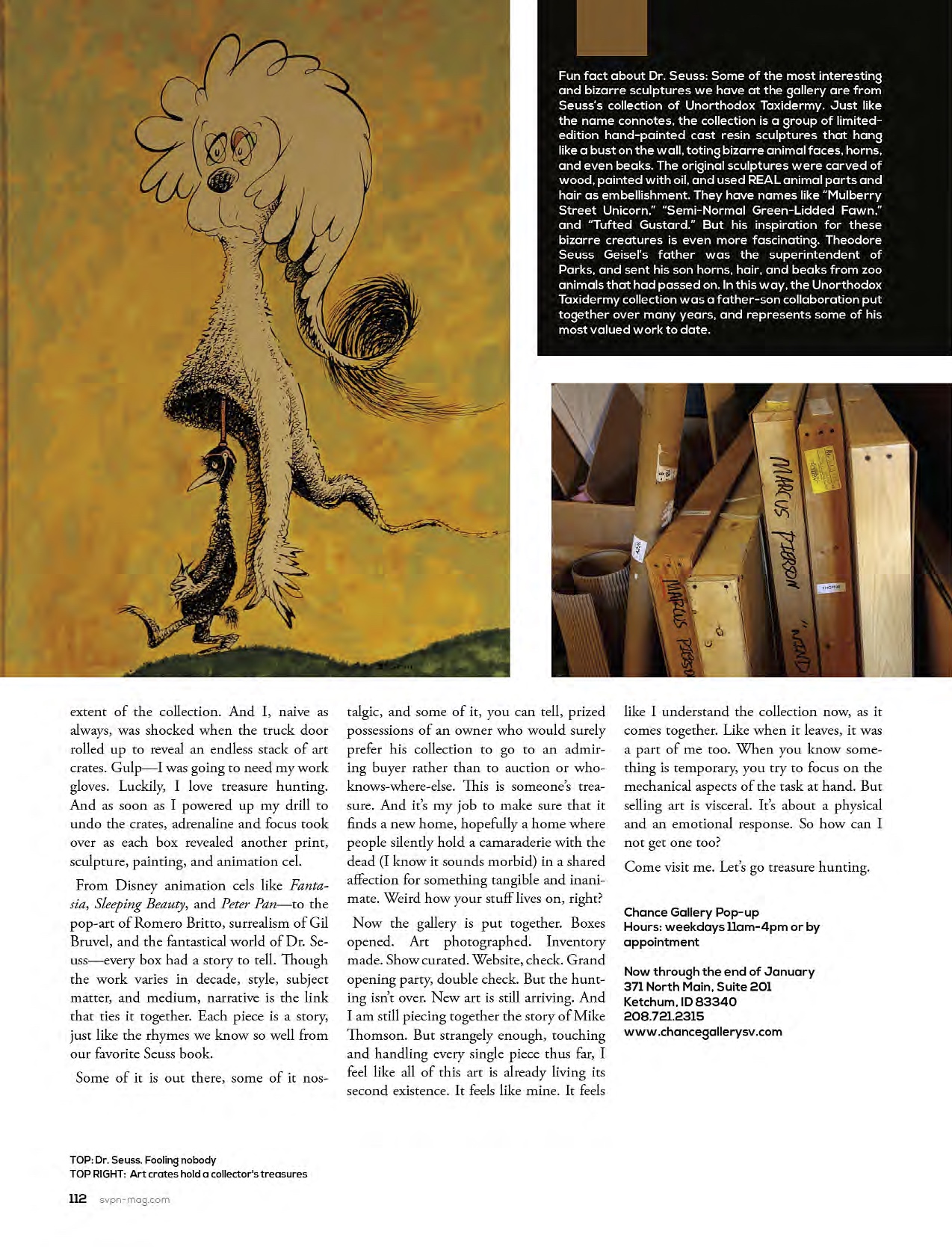SVPN Winter Issue 2015
Chance Gallery: Estate Sale or Treasure Hunt?
One of my most prized possessions was purchased at an Estate Sale when I was 14 years old. I remember it vividly because I had to beg the family to hold the coat (a magnificent Hudson Bay Company wool number with toggle buttons, a detachable hood, and animal appliqué) while I pedaled back to my house to grab the $30 I needed to make it mine. My friends all asked me if I felt weird wearing a dead woman’s coat. “No”, I replied, “this coat awesome, and she would have wanted someone else to love it and care for it like she had.” I still have the coat. I have cared for it impeccably, and I whisper a small thank you to my unknown benefactor every time I catch a glimpse of myself looking super fly wearing it.
The estate sale that THIS article is about, holds a lot of treasures — just like that coat. Mike Thomson had a house that was curated a bit like the Barnes Museum in Philadelphia. Sometimes, there was so much art clinging to the walls, that you could no longer see the walls themselves. Everywhere you looked — art. So when Mike’s brother Scott started the insurmountable task of figuring out what to do with it all, he came up with an idea. Instead of selling it off as a lot, getting everything liquidated as quickly as possible, he would much better honor his brother, allow the collection to be appreciated, and have a ton more fun, in a gallery atmosphere. So he started Chance Gallery. A pop-up that will keep its doors open through January, to allow the public to come and view Mike’s legacy, or start some new memories with some of these fabulous pieces.
Fun Fact on Dr. Seuss: Some of the most interesting and bizarre sculptures we have at the gallery is Seuss’s collection of Unorthodox Taxidermy. Just like the name connotes, the collection is a group of limited-edition hand-painted cast resin sculptures that hang like a bust on the wall, toting bizarre animal faces, horns, and even beaks. The original sculptures were carved of wood, painted with oil, and used REAL animal parts and hair as embellishment. They have names like “Mulberry Street Unicorn”, “Semi-Normal Green-Lidded Fawn”, and “Tufted Gustard”. But his inspiration for these bizarre creatures is even more fascinating. Theodore Seuss Geisel’s father was the superintendent of Parks, and sent his son horns, hair, and beaks from Zoo animals that had passed on. In this way, the Unorthodox Taxidermy collection was a father-son collaboration done over years, and some of his most valued work to date.
I applied for the job immediately after reading the words ‘run a pop up gallery’ in the job description. This simple line was oh-so-enticing because I love running things, and, as a millennial who has already switched careers half a dozen times, I rarely get an opportunity for creative freedom. The added bonus that I love art and mentally stimulating work just sealed the deal. Two interviews later and we were putting my office chair together waiting for the art to arrive. Here, I would like to give Scott some credit for being very relaxed for what he knew would be an overwhelming day. He had seen the art. He knew the extent of the collection. And I, naive as always, was shocked when the semi-door rolled up to reveal an endless stack of art crates. Gulp — I was going to need my work gloves. Luckily, I love treasure hunting. And as soon as I powered up my drill to undo the crates, adrenaline and focus took over as each box revealed another print, sculpture, painting, animation cel…
From Disney animation cels from Fantasia, Sleeping Beauty, and Peter Pan — to the pop-art of Romero Britto, surrealism of Gil Bruvel, and the fantastical world of Dr. Seuss — every box had a story to tell. Though the work varies in decade, style, subject matter, and medium, narrative is the link that ties it together. Each piece is a story, just like the rhymes we know so well from our favorite Seuss book.
Some of it is out there, some of it nostalgic, and some of it, you can tell, were prized possession of an owner that would surely prefer his collection to go to an admiring buyer rather than to auction or who-knows-where-else. This is someone’s treasure. And it’s my job to make sure that it finds a new home, hopefully a home where people silently hold a camaraderie with the dead (I know it sounds morbid) in a shared affection for something tangible and inanimate. Weird how your stuff lives on, right?
Now the gallery is put together. Boxes opened. Art photographed. Inventory made. Show curated. Website, check. Grand opening party, double check. But the hunting isn’t over. New art is still arriving. And I am still piecing together the story of Mike Thomson. But strangely enough, touching and handling every single piece thus far, I feel like all of this art is already living its second existence. It feels like mine. It feels like I understand the collection now, as it comes together. Like when it leaves, it was a part of me too. When you know something is temporary, you try to focus on the mechanical aspects of the task at hand. But selling art is visceral. Its about a physical and an emotional response. So how can I not get one too?
Come visit me. Let’s go treasure hunting.
So what makes an estate sale so great for the customer? Prices. Finding art and collectibles via galleries specific to the artist or medium means you pay a higher-end retail, bordering on appraisal and prediction rather than market value. And auction sites, with commissions sometimes going to three people before the seller takes their cut, try to go, obviously, to the highest bidder. At an estate sale, however, the family, trust, or PR has a fixed number of time to sell everything. So not only are the items priced significantly below retail, but they are also open to offers. In our case, with many of the items being in the collectible category, you can also count on your investment accruing value the longer you hold onto it. I know I am a salesman, but it seems like a win-win.





